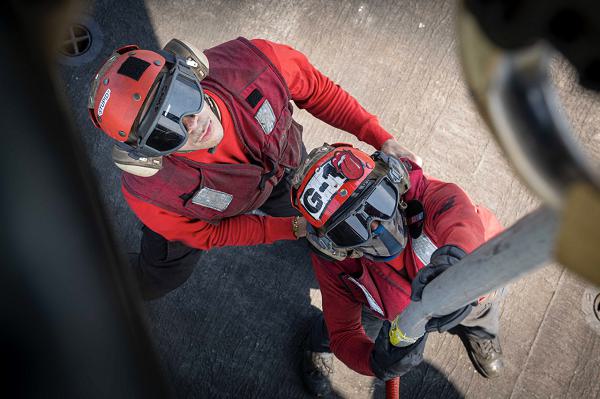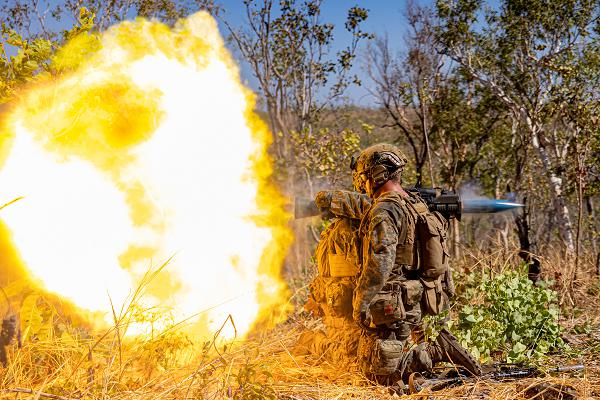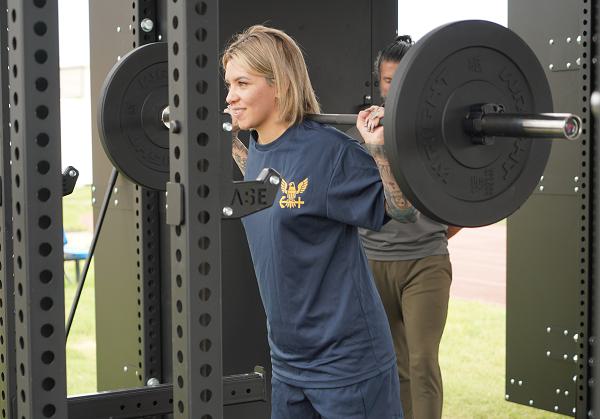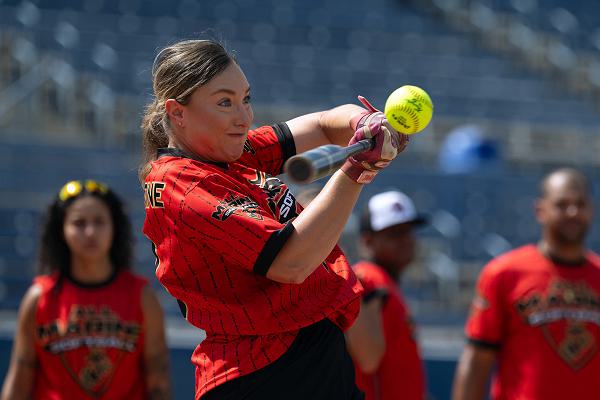- Details
- Hits: 1365

Atlantic Ocean. (September 7, 2024): U.S. Navy ships have fired thousands of rounds in America’s battle against Houthi terrorists in Yemen, underscoring the need for rapid resupply of ammunition while underway. In this photo by MC2 Merissa Daley, Aviation Ordnancemen 3rd Class Davonte Camp and Lonnie Shive secure ammunition delivered by a Navy MH-60S Sea Hawk helicopter onto the deck of the Nimitz-class aircraft carrier USS Dwight D. Eisenhower. These munitions specialists play a vital role in keeping warships resupplied with the proper mix of bombs, missiles, or standard ammunition while at sea.
They are charged with managing all types of ammunition on Navy aircraft and ship-board defense systems. Their duties include inspecting, maintaining, and repairing mechanical and electrical weapons ordnance systems on aircraft as well as their ammunition releasing launching devices. They are also responsible for stowing, assembling, servicing, and loading munitions including mines, torpedoes, missiles, and rockets while operating armories around the clock.
To become an Aviation Ordnanceman, candidates must have a high school diploma, be a U.S. citizen, and eligible for a secret security clearance. Applicants should have strong math skills and aptitude for working with tools, equipment, and machinery.
Important physical attributes include a high level of fitness, normal use of your hands, and normal hearing, color, and depth perception The job also requires performing highly detailed work, keeping accurate records, and the ability to work as a team in high pressure situations.
- Details
- Hits: 1733

Mount Bundey Training Area, Australia. (September 4, 2024): In this photo by Corporal Juan Torres, Lance Corporal Eli Gregg assists Lance Corporal Ryan Waskosky who is firing a Multi-Role Anti-Armor Anti-Personnel Weapons System (MAAWS) during a training exercise led by the Australian Army’s 1st Brigade. The “Yanks” cross-trained Aussie troops in the employment of this devastating weapon during live-fire exercises at this sprawling military training area.
The MAAWS is an 84mm lightweight, man-portable, direct-fire recoilless rifle that is effective against light/medium armor, personnel in open, and bunkers and structural targets out to 4,300 feet. The system consists of the M3A1 Carl Gustaf Recoilless Rifle, a fire-control system, and a backup reflex sight in case the primary optic malfunctions.
Designed specifically for urban warfare, the MAAWS supplements other shoulder fired rocket launchers currently in use, but with some significant advances.
First, the MAAWS is reloadable versus the single shot Light Anti-tank Weapon (LAW) and these additional rounds dramatically increase the options available to an infantry platoon. These munitions include smoke, illumination, anti-personnel, armor penetration, and bunker or hardened-facility penetration rounds.
- Details
- Hits: 1887

Westfield, Massachusetts. (August 31, 2024): In America, everyone has the right to demonstrate, march, and protest and such activities are protected under the First Amendment to the U.S. Constitution. In this photo by Jay Hewitt, members of the 104th Fighter Wing Security Forces Squadron conduct riot control training with civilians volunteering to function as an unruly crowd. The event offered riot control teams invaluable training in crowd control and tactical strategies.
While legitimate protests are an essential right, there are times when these types of gatherings get out of control and law enforcement is forced to step in. Websters describes a civil disturbance as “an unlawful assembly that constitutes a breach of the peace or an assembly of individuals that creates a threat of property damage, violence, or other unlawful acts.” Responding to these disturbances requires understanding proper crowd control tactics that protect life and property without unduly restricting a citizen’s right to protest.
When training for riot control, there are some essential skills and techniques that security officers should learn. The first task is to have a concise plan in place on how to deal with crowd control before things get out of hand. Officers should have clearly defined roles in managing unrest and they need to understand under what circumstances they can use force or make arrests.
- Details
- Hits: 1656

Alpena Combat Readiness Training Center, Michigan. (September 2, 2024): The devastating impact of unmanned aerial vehicles (UAVs) on the battlefields of Ukraine has prompted the Air Force to embrace the Kestrel JSX-2 microjet, a small, agile aircraft to simulate against such threats. In this photo by Technical Sergeant Tristan D. Viglianco, a JSX-2 microjet participates in Exercise Northern Strike 2024-2, the Air National Guard’s premier reserve component training event. More than 6,300 personnel from thirty-two states as well as “several international participants” joined in the action, hosted at the National All-Domain Warfighting Center.
The Air Force is using this light aircraft primarily for training purposes, particularly in simulating enemy unmanned aerial systems during large-scale military exercises like Northern Strike. The microjet’s small size, speed, and maneuverability make it an effective tool for replicating the behavior of UAVs and cruise missiles like those being launched over the skies of Ukraine.
These tiny, homebuilt microjets, developed by SubSonex Aircraft, are extremely light with an empty weight of just five hundred pounds and a length of sixteen’ 6” feet with a wingspan of eighteen feet. The jet has a maximum speed of 287 miles per hour and is valued at $725,000. The aircraft is used as a platform for pilots to train in various skills including detection, identification, and destruction of UAVs in a live-fly environment.
- Details
- Hits: 899

Newport News, Virginia. (September 1, 2024): The Navy has opened a first of its kind outdoor fitness pavilion here to serve the athletic needs of Sailors living at the Huntington Hall Naval Berthing Facility. In this photo by Max Lonzanida, a Sailor prepares to perform squats at the facility which opened this week. The eight hundred square foot structure of dedicated fitness space is modular, hurricane resistant, and utilizes solar lighting to remain open to Sailors to utilize 24/7. The pavilion can accommodate up to 120 Sailors at any given time and offers a variety of free weights, kettle balls, jump ropes, workout balls, pull up bars, climbing ropes, squat racks, and other fitness equipment. The facility was the brainchild of the leaders of Naval Weapons Station Yorktown and the staff from the Morale, Welfare and Recreation department.
The facility is designed for warfighters that work on ships with irregular schedules who need a good work out day or night. It took about eight-months and over $325,000 to create the open-air gym that offers a variety of cross-fit and high intensity interval exercises. There are spaces for pull ups, several climbing ropes, bench press, axle attachment points for barbel weights, and several squat rack stations. The gym has also become popular for group sports sessions such as basketball tournaments and dodgeball events, among others.
The Navy is planning to open facilities like these at all major land-based ports in the U.S. to enhance the quality of life of Sailors and their families.
- Details
- Hits: 1076

Oklahoma City, Oklahoma. (August 31, 2024): The All-Navy Women's team dominated the competition in a series of softball tournaments this week winning bragging rights as the best team in 2024. In this photo by the DOD’s EJ Hersom, Marine Corps Staff Sergeant Bailey Stiwinter swings at the ball during the home run derby competition at the 2024 Armed Forces Men’s and Women’s Softball Championship.
The event featured top athletes from the Army, Navy, Air Force and Marine Corps battling it out at Oklahoma City’s Devon Park. The competition involved a three-day double round robin series followed by an additional two-day elimination championship to determine which team would claim the crown.
The event is sponsored by U.S. Armed Forces Sports, an affiliate member of USA Softball, which has held softball competitions dating back to 1972. Teams are comprised of active duty, reserve, and national guard personnel from military installations across the world. This year, both the All-Navy Women’s team and All-Army Men’s team were defending their 2023 titles.
After coming into the double elimination championship series as the third seed, the Navy All-Women’s team got off to a shaky start with a 6-8 loss to the Air Force in the first round before rallying to beat the Marine Corps 11-10.


